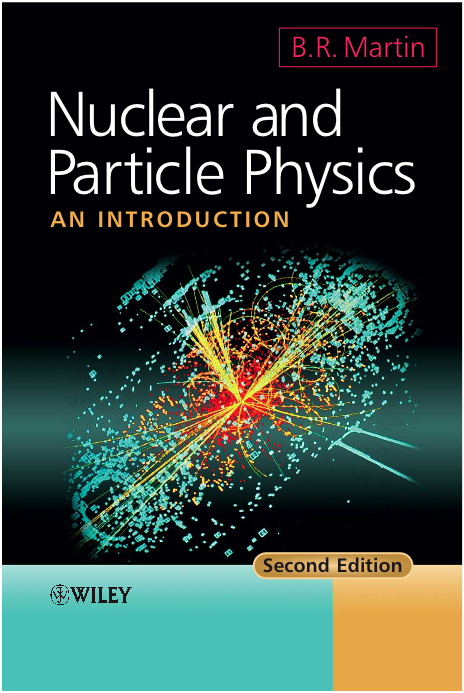454 + xviii pages.
Price: hardback (ISBN-10: 0470742747, ISBN-13: 978-0470742747),
£90.00 (UK pounds); paperback (ISBN-10: 0470742755, ISBN-13:
978-0470742754) £34.95 (UK pounds).
Ordering information from John Wiley worldwide is
hereIt is common practice to teach
nuclear physics and particle physics together in an introductory
course and it for such a course that this book was written. The
material presented is such that different selections can be made
for a short course of about 25-30 lectures depending on the
lecturer’s preferences and the students’ backgrounds. On the
latter, students should have taken a first course in quantum
physics, covering the traditional topics in non-relativistic
quantum mechanics and atomic physics. A few lectures on
relativistic kinematics would also be useful, but this is not
essential, as the necessary background is given in an appendix and
is only used in a few places in the book. I have not tried to be
rigorous, or present proofs of all the statements in the text.
Rather, I have taken the view that it is more important that
students see an overview of the subject, which for many,
probably the majority, will be the only time they study nuclear
and particle physics. For future specialists, the details will
form part of more advanced courses. Nevertheless, space
restrictions have still meant that it has been necessarily to make
a choice of topics and doubtless other, equally valid, choices
could have been made. This is particularly true in Chapter 8,
which deals with applications of nuclear physics, where I have
chosen just three major areas to discuss and also applies to
Chapter 9, where some of the outstanding problems of nuclear and
particle physics are briefly discussed.
The structure of this edition edition follows closely that of the
first edition. Changes include the rearrangement of some sections
and the rewriting and/or expansion of others where, on reflection,
I think more explanation is required, or where the clarity could
be improved; the inclusion of a number of entirely new sections
and two new appendices; modifications to the notation in places to
improve consistency of style through the book; the inclusion of
additional problems; and updating the text, where appropriate. I
have also taken the opportunity to correct misprints and errors
that were in the original printing of the first edition, most of
which have already been corrected in later reprints of that
edition. I will continue to maintain the book’s website,
(www.hep.ucl.ac.uk/~brm/npbook.html) where any future comments and
corrections will be posted.
Problems are provided for all chapters and appendices except
Chapter 9 and Appendices A and D. They are an integral part of the
book. The problems are mainly numerical and require values of
physical constants that are given in a table in the
introductionary pages of the book. A few also require input
data that may be found in the references given in notes at the
start of the book. Solutions to the problems are given in Appendix
F.
Finally, a word about footnotes: readers have always had
strong views about these, (‘Notes are often necessary, but they
are necessary evils.’ – Samuel Johnson), so in this book they
are designed to provide ‘non-essential’ information only. Thus,
for those readers who prefer not to have the flow disrupted,
ignoring the footnotes should not detract from understanding the
text. Nuclear and particle physics have been, and still are,
very important parts of the entire subject of physics and its
practitioners have won an impressive number of Nobel Prizes. For
historical interest, I have therefore noted in the footnotes
many of the awards for work related to the field.
In preparing a book of this
length, some errors and misprints are inevitable. Please notify me
of any you may find. I would also be grateful for any other
general comments. Any errors, misprints and comments will be
listed
here.
Errors, misprints and comments in the 2011 printing of the second
edition are listed
here,
and for the 2009 printing of the second edition
here.
A list of corrections, updates and comments for the first
(2006) printing of the first edition may be found
here,
and for the 2007, and later, reprints of the first edition,
here.

